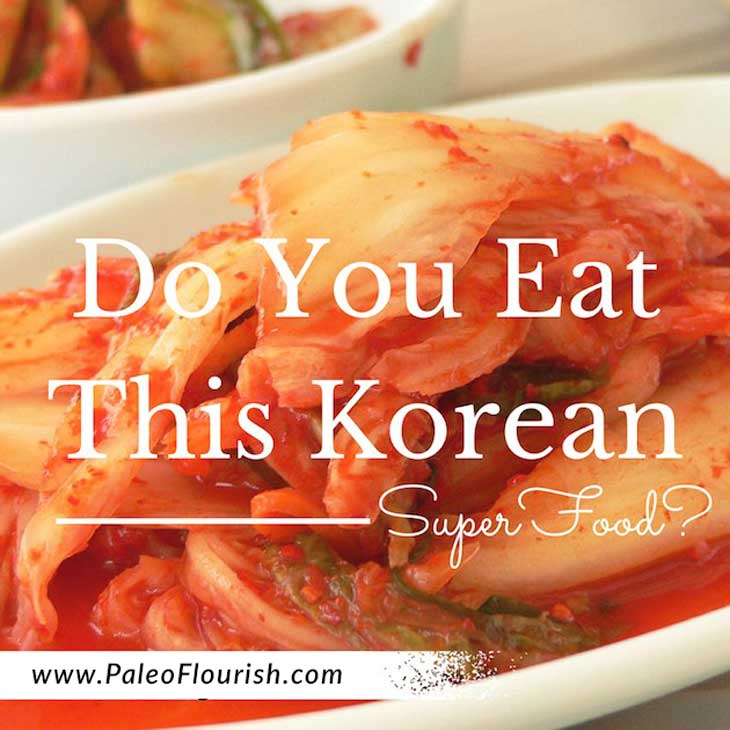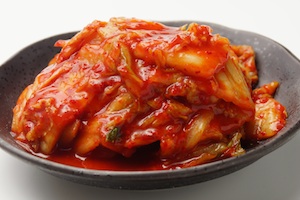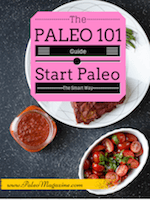Do You Eat This Korean SuperFood?

Most people either love or hate fermented foods.
You know that particular smell that yogurt, kefir, or – heaven forbid – natto have?
Yeah, I can’t stand that smell, or the accompanying taste.
Oddly, though I like a few fermented foods.
What is Kimchi?
I could eat Kimchi with everything.
There’s nothing quite like the pungent, spicy-sour, garlicky kick when kimchi, a Korean dietary staple, hits your mouth.

If you’re not familiar with Korean cuisine, kimchi’s flavor may require acceptance in stages. But make no mistake, from its unforgettable taste to its vitality-enhancing effects on the body, kimchi is a Paleo dietary superstar and worthy of eating on a regular basis.
One of the great ways kimchi helps us is that it’s a fermented food—made by brining cabbage leaves (usually, but it can also be made with other veggies like radishes or cucumbers) and then fermenting them in a scorchy mixture of garlic, chili powder, ginger, fish sauce and/or salted shrimp.
The fermentation process leaves it chock full of beneficial probiotics–the “good bacteria”, delivered straight to our digestive system, where they improve gut health and nutrient absorption.
Whether it’s a few forkfuls eaten pre-meal while cooking, all by itself, or as a topping or side, it’s embraced as a super food by Paleo enthusiasts worldwide. Check out these great reasons to give kimchi (and perhaps other fermented foods) a place at your table.
Why is Kimchi so Healthy?
1. The probiotics found in fermented foods like kimchi help strengthen mucosal barriers (in our respiratory and intestinal tracts), which are our first defense against pathogens. And being that 75% of our immune system exists within the gut, having a healthy one is an important key to our immunity.
2. The commonly used ingredients for making kimchi—ginger, garlic and pepper—have all been shown to bolster immunity and may stop or shorten the symptoms of cold and flu viruses.
3. Kimchi is low in calories and high in fiber — a 2-0z. serving has just 25 calories and 1 gram of fiber.
4. Full of vitamins and minerals like vitamin A, several B vitamins, iron, calcium, and selenium, kimchi offers a dense source of these helpful nutrients. They support muscle growth, strengthen the immune system, and help improve circulation.
5. It’s an ally for weight loss. Because it has a high lactobacillus content (one of the many good bacteria for optimum health), kimchi can help control appetite by lowering blood sugar levels. Also, with its high fiber content, it also helps you feel fuller longer and may alleviate hunger, so you’re less likely to overeat or eat less healthy foods.
6. Regularly eating kimchi may decrease the risk of developing some cancers, including stomach cancer. The antioxidants and flavonoids abundant in cabbage have been found to play a role in cancer prevention. Additionally, cabbage contains a fair amount of glucosinolates—compounds that when digested, convert into isothiocyanate, a potent anti-cancer phytochemical found in the cruciferous veggie family.
7. Kimchi can lower cholesterol levels when eaten every day. The garlic used in making it is a good source of allicin and selenium. Allicin reduces cholesterol levels, which can lower your chances of strokes and heart attacks. Selenium helps decrease cholesterol by stopping cholesterol plaque from building up on artery walls.
Is Kimchi Paleo?
Yes – as if you couldn’t have guessed by all the health benefits I just told you about.
Bon Appétit!
While kimchi is a great addition to a Paleo diet, this fermented favorite should be eaten with a nod to moderation. Too much is not necessarily a good thing as going overboard with kimchi can lead to digestive distress for some. Also, if you’re not making your own kimchi, then watch out for non-Paleo ingredients (like sugar) in store-bought kimchi.
Images: Copyright (c) Nagyman cc and photosomething from Fotolia

